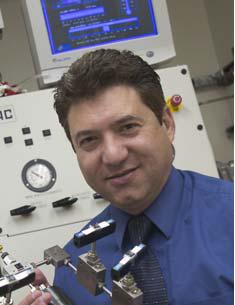This achievement is expected not only to accelerate the development of an entirely new family of storage materials, but also to have far-reaching implications in the fields of energy technologies and synthetic chemistry.

Researchers from the US Department of Energy have developed a reversible way to create aluminum hydride - a hydrogen storage material with a high content. This achievement is expected not only to accelerate the development of a completely new family of storage materials, but also to have far-reaching implications in the fields of energy technologies and synthetic chemistry. "We believe that our research provides a viable way to recreate aluminum hydride, a material used to store high-content hydrogen," says Dr. Ragaiy Zidan, the principal investigator in this venture.
The research team has developed a closed and innovative route to create aluminum hydride, also known as alane, which can offer a cheap method for re-creating a hydrogen storage material, a material capable of releasing and absorbing hydrogen cyclically, over and over again. In this process, the hydride is produced using an electrochemical method, and the starting material is regenerated directly by hydrogen. Although many attempts have been made in the past to prepare allanes electrochemically, none of these attempts have been perfectly successful.
For years, one of the main obstacles to realizing the potential of a hydrogen economy has been hydrogen storage. Storage in a solid substrate, using solid materials such as metals, which are able to absorb hydrogen and release it if necessary, has many safety and practical advantages compared to storing hydrogen as a liquid or gas, and many such materials have been prepared and studied.
Over the years, a number of substances were discovered that reached and even exceeded the threshold conditions for the gravimetric and volumetric activity of the US Ministry of Energy standards. However, most of these materials lack the thermodynamic and kinetic properties that allow them to release hydrogen when needed, and to be both efficient and cheap enough to reabsorb additional hydrogen.
Alans do have the required properties, but they are considered impractical due to the high pressure required to fuse hydrogen and aluminum to resume activity. Other production methods that use chemical synthesis often also produce by-products of stable chloride salts that prevent their reusability. The state-of-the-art electrochemical method for creating alanes, demonstrated by the research team, overcomes these two obstacles together.
Along with this research, the team of scientists developed innovative ways to assist in the separation and production of aluminum hydride, ways that are also suitable for the production of other metal hydride conjugates that could be used in the development of various hydrogen storage materials.
The researchers expect that the findings of this study will accelerate the development of an entirely new family of similar materials that could be used in hydrogen economy, batteries and other energy storage applications. In addition, the aforementioned research will be able to significantly affect other fields related to thin layers, chemical syntheses and the recycling and re-production of other materials.

One response
Well, then maybe bring some practical details such as: how many cc of hydrogen can be stored in a cubic decimeter of aluminum?